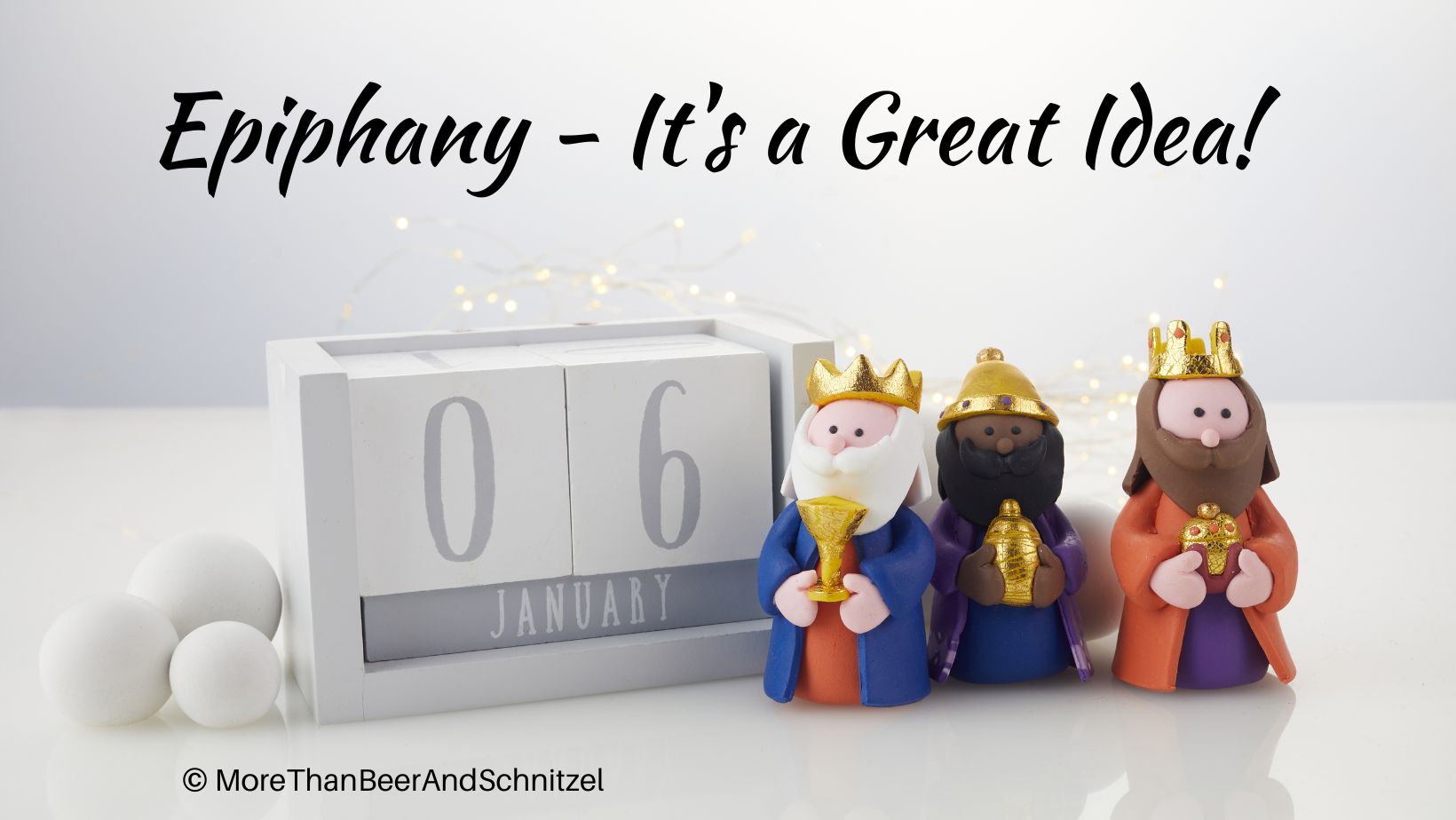Epiphany, Dreikönigstag, or Heilige Drei Könige on January 6th ends the Twelve Days of Christmas or Rauhnächte. It commemorates when the three Wise Men or three Holy Kings visited the Christ Child by following the star and brought him gifts of gold, frankincense, and myrrh.

(Eastern) Orthodox Christians often celebrate Christmas on that day, and/or remember Jesus’ baptism. Therefore many customs are associated with water, like bathing in water in Russia or diving for a cross thrown into a body of water in Florida (Tarpon Springs), Bulgaria (Gabrovo), and Australia (Glenelg).
Other terms for this holiday are Theophany, Erscheinung des Herrn (Revelation of God incarnate as Jesus Christ), Epiphanias, Epiphaniasfest or Dreikönigsfest; in Austria sometimes Weihnachtszwölfer (Christmas Twelve). It’s a public holiday in Austria, in some cantons in Switzerland, in the three German states of Bavaria, Baden-Württemberg, and Saxony-Anhalt, as well as in many other European countries like Spain, Croatia, Italy, Poland, Greece, Sweden, and Finland.
Sternsinger
In many regions in Europe on January 6th, kids (and adults) dress up like the three Kings or Weise (wise people) plus a star-carrier go from door to door and collect money for charity. They are called Sternsinger and often carry a star ahead of them. They represent the three wise men.
In the 3rd century they were made into kings and in the 9th century received the names Caspar, Melchior, and Balthasar.

We find written references to the Sternsingen or Dreikönigssingen as early as 1541, though that doesn’t mean it hadn’t been around before. After the Reformation in 1517, many Catholic convent schools (Klosterschulen) in now Protestant regions lost their funding, and were supplementing their income by having Sternsinger collect money. By the end of the 19th century, asking for donations was deemed begging and forbidden. The Sternsingen was revived in Germany and Austria by refugees from Silesia after World War II.


The way the Dreikönigssingen is done depends on the region and church. You will find it predominantly in Catholic areas, though the tradition is also observed in Scandinavia which is mostly Lutheran. In many communities, the event starts out with a service in the church, possibly a play, before the children are sent out. They go from door to door, sing songs, recite a poem, or give a little speech.
The Sternsinger have collected millions of Euros over the years which were donated to different charities that help children in need all over the world. Since 2004, the Sternsingen has been on the list of the UNESCO list of Intangible Cultural Heritage.

C+M+B Blessing
The star singers (or an accompanying adult) bless the house by marking the door or door frame with blessed chalk with the letters C, M, and B as well as the year. The way it is written varies:
20*C+M+B+22 (one star, three crosses)
20+C+M+B+22 (four crosses)
20-C+M+B-22 (with a third cross above the M)
20 C+M+B 22
20*C+M+B*22
While it makes sense to associate the letters with the names of the Three Kings, Caspar, Melchior, and Balthasar, the letters actually stand for the Latin “Christus mansionem benedicat”, Christ bless this house. At least that has been the interpretation since the 1950s.


Dreikönigskuchen - King Cake
In Switzerland, Dreikönigskuchen (also called King Cake, Twelfth Night Cake) is served for breakfast on January 6th. It is a bread or cake made from sweet yeast dough, rolled into multiple balls arranged in a circle with a larger piece in the middle. (see picture) The cake has one token, a dried bean for example, baked into it. Whoever gets the piece with this token is king or queen for the day.
You can buy King Cake in other European regions. The recipes and appearances vary greatly but all of them contain a small token. If it’s not a dried bean, it may be an almond or a coin or a small figurine like a king or baby. If you buy a cake at the bakery or in the store it often comes with a paper crown (for the king or queen).
If you are looking for a recipe, see this link to Newly Swissed or My Dinner.

It is not entirely clear where and when the custom of a cake for Epiphany arose or when and why something is baked into it. It is said that it dates back to before the Reformation 1517. Written documents from 1561 and 1572 show references to Dreikönigskuchen and the custom of hiding a dried bean in it.
Max Währen is responsible for reviving the custom of the Bohnenkönig (bean king) in the 1950s. Währen was an insurance agent who researched bread and pastry in his freetime.
Sources and Resources
- Wiki – Sternsinger
- Wiki – Erscheinung des Herrn
- YouTube Playlist
- The German Way
- Newly Swissed



Great article.
Thank you!